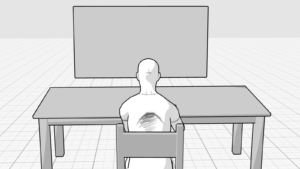



This week, I developed a detailed storyboard for the documentary recording of the installation exhibition. To effectively capture the interaction between the audience and the installation, I primarily employed medium close-up shots at eye level. This perspective not only highlights the audience’s natural reactions but also enhances the immersive experience, allowing viewers to engage more deeply with the footage.
The storyboard incorporates a shot/reverse shot technique to emphasize the dynamic interaction between the audience and the installation. On one hand, the shots document how viewers gradually synchronize their breathing with the installation’s background music (BGM) and visual cues, achieving a steady rhythm. On the other hand, they capture the way in which the installation visually responds to the audience’s breathing patterns, demonstrating the reciprocal influence between the two and reinforcing the sense of interactivity.
A major challenge in the filming process is the inability to implement additional lighting adjustments within the exhibition space. This limitation poses constraints on the visual quality and atmospheric composition of the footage. To address this issue, I have referenced relevant visual works and artistic styles to identify optimal approaches for utilizing natural light. By making full use of the available ambient lighting in the exhibition space and employing strategic composition, camera movement, and color grading, I aim to compensate for the lack of artificial lighting while maintaining the intended visual and narrative impact.
This storyboard design not only focuses on the artistic expressiveness of the installation but also seeks to enhance the immersive experience through audiovisual storytelling. The goal is to accurately capture the interactive atmosphere of the exhibition and effectively convey it through the documentary.

